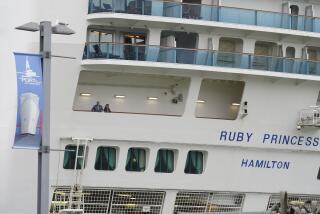These Doctors Make Shipboard Calls
- Share via
Soon after the woman had disembarked from the cruise ship for a day of sightseeing in Naples, she got hit by a bus. It could have been worse; her arm was fractured.
The Italian doctor who treated her applied a cast that encased not only the woman’s arm but much of her torso. By the time she returned to the ship, the cumbersome cast was making her think she would have to fly home. But the ship’s physician had another idea.
Using the ship’s new telemedicine system, which allows real-time audio and video transmission, the physician conferred with an orthopedic specialist in Los Angeles. The orthopedist examined the woman by video camera and then explained to the ship’s doctor how to remove the cast. Next, the orthopedic doctor drew diagrams, also transmitted to the ship’s video screen, explaining how to apply a cast that left her torso free. The woman stayed on board and enjoyed the rest of the cruise.
The ship was the Grand Princess, the 2,600-passenger vessel launched last year by Princess Cruises. Princess is believed to be the only cruise line with such sophisticated capabilities.
The system used by Princess, called SeaMed, relies on a satellite link to connect the ship’s physician directly to physicians at Cedars-Sinai Medical Center in Los Angeles. The communication is similar to a live TV broadcast. The ship’s doctor can also take an X-ray or an electrocardiogram and display it on a video screen for transmission to the SeaMed station at Cedars. There, 30 nurses, 32 emergency physicians and 54 specialists in orthopedics, pulmonary medicine, surgery, neurology, cardiology and other areas are available to respond.
The on-call specialists will respond to emergency calls from a ship within 45 minutes, said Dr. Spencer Koerner, medical director of telemedicine and international health for Cedars-Sinai Health System; he also is chairman of the board of SeaMed.
Sophisticated telemedicine systems on cruise ships may become common in the next five years, said Dr. Carter Hill, medical director for Holland America Line and Windstar Cruises. He has been evaluating such systems for possible use on both cruise lines.
Representatives of other cruise lines say they are looking at telemedicine too, hoping to upgrade from present systems, which often rely on radiotelephone contact with a major medical center for consultations when necessary.
Renaissance Cruises, for instance, plans to equip four ships with a satellite video link to Johns Hopkins Medical Center in Maryland, said Caryl Svendsen, a cruise line spokeswoman. April 1 is the target start-up date.
SeaMed costs $45,000 or more per ship to install, according to Koerner, but diverting a ship to a port for medical care can cost the line $500,000 or more, depending on the ship’s location, Hill said.
The cruise line absorbs the cost of evacuation if the emergency is due to an accident on board. Otherwise, the patient pays for evacuation.
Since September, there have been five emergency consultations with SeaMed, Koerner said. One passenger, diagnosed with respiratory failure, was given intensive medical treatment and got better in time to celebrate her 60th wedding anniversary on board, he said. A man with a ruptured tendon in his hand was advised by his personal physician to fly home for surgery, but the Cedars orthopedist advised splinting, and the man stayed on the cruise.
The cruise line bills passengers who use SeaMed services. The cost is $500, said Julie Benson, a spokeswoman for Princess Cruises. Other services are billed as needed. An electrocardiogram, for instance, costs $50; a lower-extremity X-ray, $75.
Insurance coverage varies. A spokeswoman for Kaiser Permanente said that shipboard emergency medical services would probably be covered like emergency services that are provided out of the subscriber’s service area.
Healthy Traveler usually appears on the second and fourth Sunday of the month.
More to Read
Sign up for The Wild
We’ll help you find the best places to hike, bike and run, as well as the perfect silent spots for meditation and yoga.
You may occasionally receive promotional content from the Los Angeles Times.






